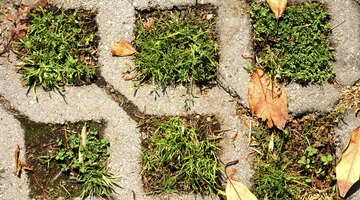How to Install Turfstone
Turfstone pavers, sometimes referred to as grass pavers, can give you an aesthetically pleasing alternative to a solid concrete driveway or parking area. The honeycomb design of these pavers allows grass to grow in their holes or openings while still providing enough structural support for heavy traffic use.

Grass pavers are billed as environmentally friendly. They not only solve the problem of permanently destroying green space, but also help to reduce soil erosion and storm water runoff.
Things You Will Need
- Tape measure
- Hammer
- Wood stakes
- String
- Landscaping spray paint
- Flat-edge shovel
- High-frequency plate vibrator (3,500 to 5,000 cycles per second)
- Landscape fabric
- Crushed gravel
- Fine aggregate concrete sand
- Two-by-four screed board
- Rubber mat for the plate vibrator
- Garage broom
- Grass seed, fertilizer and topsoil
Tip
Instead of growing grass, you can use crushed gravel to fill the holes of the pavers. Landscape edge restraints can be installed against the perimeter pavers to help restrict shifting.
Warning
Check for any underground utility cables or pipes before excavating.
-
Mark off the area where you intend to install the Turfstone pavers. Take accurate measurements with a tape measure, and drive wood stakes into the ground to indicate the corners. Start at one stake -- tie string around the base of the stake. Pull the string to the second stake and tie it around the base of this stake. Continue to tie the string around the remaining corners until you return to the first stake.
-
Spray along the top of the string with landscaping spray paint to indicate on the ground the perimeter of the area. Remove the stakes and string and use a flat-edge shovel to cut into the ground along the sprayed lines. Excavate the entire area to a depth of 10 inches for light-traffic use, or 12 inches for heavier or vehicle use. Save the soil to use later.
-
Compact the bottom of the area with a high-frequency plate vibrator. Lay landscaping fabric over the bottom and run it up the side walls. Pour in 6 inches of gravel for light-traffic use or 8 inches for heavy-traffic use. Compact the gravel to a uniform thickness.
-
Spread 1 to 1 1/2 inches of fine aggregate concrete sand over the top of the gravel. Use a two-by-four screed board to smooth out the sand and to ensure a consistent thickness across the length and width of the area. Dampen the sand, but not to the point where it becomes saturated.
-
Install the Turfstone pavers on top of the sand. Start at one end, laying one row at a time, and work your way to the opposite end. Allow a minimum of 1/16 inch between the pavers. Once all of the pavers have been installed, attach a rubber mat to the plate of the vibrator and run it over the pavers to vibrate them into the sand.
-
Spread a mixture of grass seed, fertilizer and topsoil on the pavers, and sweep the mixture into the holes of the pavers, filling them up to 1/2 inch below the surface. Use some of the excavated soil to backfill along the outer edges of the border pavers. Run the vibrator over the pavers and along the perimeter of the area.
The Drip Cap
- Turfstone pavers, sometimes referred to as grass pavers, can give you an aesthetically pleasing alternative to a solid concrete driveway or parking area.
- They not only solve the problem of permanently destroying green space, but also help to reduce soil erosion and storm water runoff.
- Excavate the entire area to a depth of 10 inches for light-traffic use, or 12 inches for heavier or vehicle use.
- Compact the gravel to a uniform thickness.
- Use some of the excavated soil to backfill along the outer edges of the border pavers.
- Run the vibrator over the pavers and along the perimeter of the area.
References
Photo Credits
- Karin Lau/iStock/Getty Images
- Karin Lau/iStock/Getty Images
More Articles



